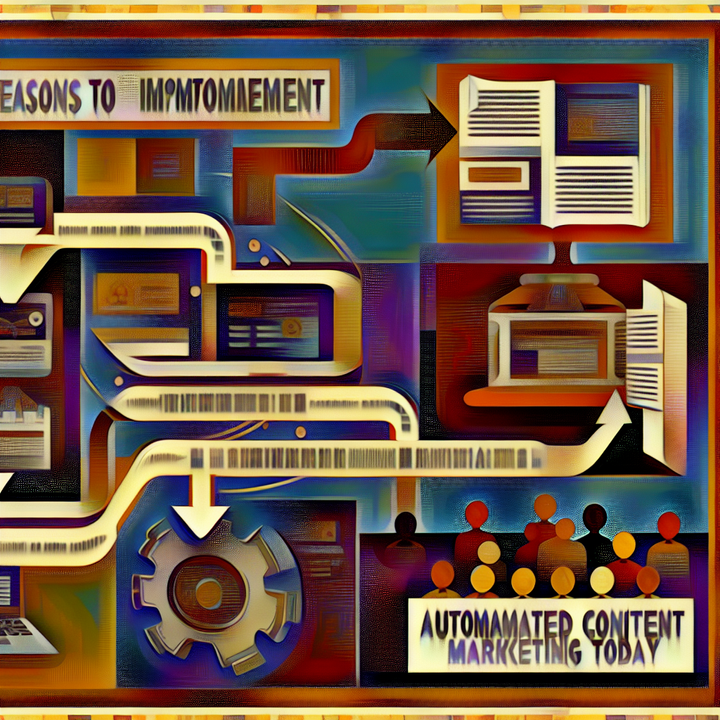The Future of Content Creation: Automation

The Rise of Automated Content Creation
Automated content creation has experienced a remarkable evolution over the past few years, driven primarily by advancements in artificial intelligence (AI) and machine learning. Initially, content automation tools were rudimentary, offering basic functionality that often required extensive manual intervention. However, the integration of sophisticated natural language processing (NLP) algorithms and predictive analytics into these systems has transformed the landscape.
Today, businesses of all sizes are increasingly leveraging content creation automation to streamline their digital marketing efforts. The adoption rates are soaring, particularly among companies aiming to scale their content marketing without a proportionate increase in workload or staffing. As AI-powered tools become more intuitive and capable, the potential for creating high-quality, SEO-optimized content automatically is becoming a reality for many organizations.
Industries ranging from e-commerce to tech startups are witnessing the benefits, showcasing how efficient and effective automated blog services and newsletter automation can be. Businesses now see automated content creation as not just a convenience but a strategic advantage, pivotal in the highly competitive digital landscape.
Why Automation is Key for Modern Content Marketing
Content marketing is the cornerstone of modern digital strategy, yet it is fraught with challenges that can often overwhelm even seasoned professionals. Automation addresses several critical pain points, making it an indispensable tool for enhancing efficiency and driving results.
Time Savings: One of the most significant benefits of content creation automation is the incredible amount of time it saves. For busy business owners or marketing managers, the ability to generate high-quality content swiftly allows for a more efficient allocation of resources.
Consistency: Maintaining a consistent posting schedule is crucial for engagement and SEO. Automated tools ensure that new, relevant posts go live as planned, without requiring constant oversight.
Scalability: For startups and growing businesses, scaling content efforts without hiring additional staff is often a challenge. Automation enables a single strategist or marketer to handle what would traditionally require a full team.
The automation solutions cater to various personas:
- Busy Business Owner: Focuses more on strategic decisions rather than day-to-day content generation.
- Marketing Manager: Benefits from seamless coordination and consistent content publishing.
- Content Strategist: Gains more bandwidth to focus on crafting overarching content strategies.
- Startup Founder: Can prioritize growth and development while automation manages the content creation.
Essential Tools and Platforms for Content Automation
The landscape for content automation tools is rich and varied. Here, we'll explore some of the most popular platforms and tools that have proven effective across different business needs and user personas.
| Tool/Platform | Description |
|---|---|
| HubSpot | An all-in-one inbound marketing platform known for its comprehensive content marketing tools, including blog posting, email campaigns, and social media scheduling. |
| Buffer | A social media management tool that allows for the scheduling of posts across various platforms, streamlining social content efforts. |
| Wordsmith | An advanced natural language generation tool that automates the creation of data-driven narratives, from financial reports to performance summaries. |
| Taleflow | Specializes in blog and newsletter automation tailored to a company’s profile, industry, and target audiences, ensuring SEO-optimized content generation and distribution. |
Each tool serves a unique purpose, whether it's managing social media presence or generating in-depth articles, making it easier for businesses to find a solution that fits their specific needs.
How Taleflow Simplifies Content Creation
At the core of Taleflow’s value proposition is its ability to simplify content creation through automation. But how does Taleflow achieve this? The process is straightforward yet powerful, designed to cater to different industries and business profiles seamlessly.
Here's how Taleflow’s platform works:
- Easy Setup: Getting started with Taleflow is incredibly easy. Users input their business profile, specify their industry, and define target audiences; Taleflow customizes the content accordingly.
- Customizability: The platform allows for extensive customization, ensuring that the tone, style, and topics align perfectly with the business’s brand identity and marketing goals.
- Ongoing Support: Taleflow provides ongoing support and updates to adapt to changing market trends and customer needs, ensuring the content remains relevant and effective.
Businesses using Taleflow have reported significant improvements in their content marketing efforts. For example, [insert fictional testimonial], a tech startup, saw a 50% increase in website traffic within three months of using Taleflow’s automated blog service.
Benefits of Automated Content for SEO
Automated content creation offers substantial SEO benefits that can significantly enhance a website's visibility and ranking on search engines. Here are some key ways in which content automation aids SEO:
- Keyword Optimization: Automated tools can efficiently incorporate relevant keywords into the content, ensuring it aligns with SEO best practices.
- Regular Posting: Consistency is critical for SEO. Automation ensures that new content is posted regularly, signaling to search engines that the site is active and relevant.
- High-Quality Content: Automated tools employing advanced algorithms can produce high-quality, engaging content that meets the search engine's criteria for value and originality.
Businesses that have adopted content marketing automation often report improvements in search engine rankings. For instance, a company integrating SEO-optimized automated blogs might notice their domain authority rising significantly, driven by fresh, relevant content consistently added to their site.
Creating Engaging and Relevant Content Automatically
For content to truly resonate with an audience, it must be engaging and relevant. Automation tools are increasingly adept at producing content that meets these criteria by leveraging user data and behavioral analytics. Here’s how automated systems achieve this:
- Data-Driven Insights: Automation tools analyze user data to identify trending topics, preferences, and behaviors, creating content that aligns with audience interests.
- User Segmentation: By segmenting audiences based on various parameters, such as demographics or past behavior, automated tools can tailor content to specific groups, enhancing relevance and engagement.
- Adaptive Content: Many advanced systems can adjust content in real-time based on user interactions and feedback, ensuring it remains pertinent and engaging.
Through these strategies, businesses can maintain high engagement levels, ensuring that their content marketing efforts translate to increased customer retention and higher conversion rates.
Measuring the Success of Your Automated Content
Performance tracking and analytics are crucial for understanding the effectiveness of automated content. Here are some key metrics and tools to consider:
- Traffic Metrics: Track website traffic, page views, and unique visitors to gauge content reach.
- Engagement Metrics: Measure likes, shares, comments, and time spent on page to assess audience interaction.
- Conversion Rates: Monitor how well the content drives actions like sign-ups, purchases, or inquiries.
- SEO Metrics: Use tools like Google Analytics and SEMrush to track keyword rankings, backlinks, and domain authority.
Adopting these metrics and using insights from tools like Taleflow’s analytics dashboard can help businesses optimize their content strategies for better results.
Cost-Effective Solutions for Consistent Content Generation
Traditional content marketing can be resource-intensive, consuming time and financial resources. In contrast, content automation offers a cost-effective alternative. The initial setup cost of automated content tools is often offset by the reduction in hours spent on manual content creation and the streamlined production process.
Return on Investment (ROI): Investing in automation yields significant ROI by freeing up resources, improving content quality, and amplifying marketing reach.
Budget Management: Automation allows businesses to allocate budget more efficiently, investing in strategy and innovation rather than routine content creation.
For small to medium-sized businesses, in particular, these cost savings can be crucial. Automation allows these businesses to compete with larger enterprises by delivering high-quality, consistent content without overextending their resources.
Future Trends in Content Automation
The future of content automation looks promising, with several exciting trends on the horizon:
- AI Advancements: As AI continues to evolve, expect more sophisticated and intuitive content creation tools that offer even richer and more nuanced output.
- Hyper-Personalization: Future tools will likely offer better personalization capabilities, creating content that is explicitly tailored to individual user preferences and behaviors.
- Integration with Other Technologies: Enhanced integrations with other technologies, such as augmented reality (AR) and virtual reality (VR), may offer new ways to engage audiences.
Businesses that stay ahead of these trends will be well-positioned to capitalize on the next wave of innovations in content marketing automation, ensuring they remain competitive in the ever-evolving digital landscape.
Implementing Automated Content Solutions in Your Business
Are you ready to leverage content automation for your business? Here’s a step-by-step guide to ensure smooth implementation:
- Assess Your Needs: Identify the specific areas where automation can bring the most benefit, such as blog posts, newsletters, or social media content.
- Choose the Right Tools: Depending on your needs, select the tools that align best with your objectives. Consider platforms like Taleflow for comprehensive content automation.
- Start Small: Implement automation in one area first, measure its effectiveness, and then scale up gradually.
- Monitor and Adjust: Continuously track performance metrics and adjust your strategies based on the insights gathered.
- Avoid Common Pitfalls: Ensure content quality remains high and avoid over-reliance on automation by incorporating human oversight where necessary.
By following these steps, businesses can effectively integrate automated content solutions, optimizing their marketing efforts and achieving sustained growth.



